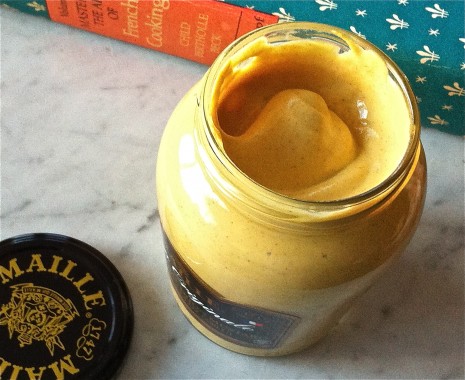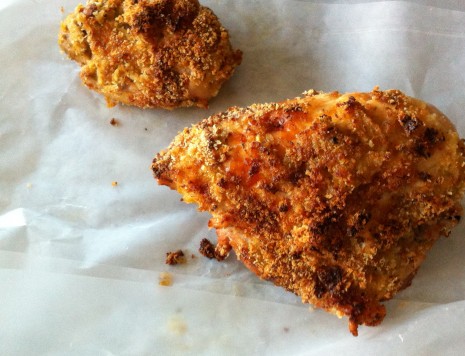DEVIL ME A CHICKEN
Nothing delivers brightness and body faster than Dijon mustard. I learned this at a young age, when a family friend brought my mother a big ceramic jar of the condiment from France. It was so noble looking, it probably would have remained untouched on a pantry shelf for years if it hadn’t been for the publication of Julia Child’s Mastering the Art of French Cooking, in 1961.
My mother read that book like a novel. But it just occurred to me this instant that she used it as a guidebook as well. One of her first forays abroad was Poulets Grillés à la Diable—chicken broiled with mustard, herbs, and bread crumbs. My father helped her coax two suspicious, balky children to the table with a uncharacteristically folksy twang that would have done Andy Griffith proud. “You mean, you deviled me a chicken?” he asked in mock amazement. My mother cracked up, we all did, and, almost without noticing, my brother and I cleaned our plates. “Devil me a chicken,” soon became a family catch phrase, employed any time one of us discovered something new and delicious.
The secret, of course, was the Dijon mustard. Although much livelier than the powdered English mustard commonplace in deviled eggs and deviled crab, it still held true to what we were familiar with: To a southerner, something that’s deviled doesn’t mean it registers on the Scoville scale, but that it’s piquant—nuanced yet provocative enough to keep you coming back for more.
Swaddling chicken pieces in a creamy, full-bodied mustard coating infuses the following mantle of bread crumbs with flavor and helps protect the meat during high-heat cooking. That moist underlayer makes any sort of sauce superfluous. Swap a blend of fresh rosemary, thyme, and mint for the tarragon and use the same formula for leg of lamb, and you have yourself Easter dinner.
Spoonfuls from my mother’s regal-looking jar of mustard soon found their way into everything from the weekly meatloaf to salad dressing and that ultimate dinner-party dish, chicken Divan. The brilliant thing about deviled chicken, though, is that it is good hot, cold, or room temperature—an asset for every season, but especially this year, when the early spring weather has been so confounding.
Chicken Broiled with Mustard, Herbs, and Bread Crumbs
Adapted from Mastering the Art of French Cooking, by Julia Child, Louisette Bertholle, and Simone Beck
Serves 4
Julia Child partially broils the chicken before smearing it with mustard and herbs, but my success with that technique depends on the oven. Below, I roast the chicken at high heat during that preliminary stage, then finish it off under the broiler. And I may as well admit to the fact that sometimes I start the chicken on the wrong side, forget to turn it over, or, when I do, leave part of the crust on the bottom of the pan. It doesn’t seem to matter. Patch the crust if need be, or loosely cover the chicken with foil if the crust starts to overbrown. One last thing: You need cayenne for its signature sharpness—an altogether different heat than the mustard—but cutting it with Spanish smoked paprika is wonderful, too.
A 3½-pound chicken, cut into serving pieces, or your favorite skin-on, bone-in chicken parts
Coarse salt and freshly ground pepper
6 tablespoons Dijon mustard
3 tablespoons finely chopped shallots or green onions
½ teaspoon finely chopped fresh tarragon or thyme
A generous pinch of cayenne pepper
A good 3 cups of fresh white bread crumbs (whizzed up in a blender or food processor)
1. Preheat oven to 500º F. Put the chicken, skin-side down, in a shallow broiler-proof pan or rimmed baking sheet and roast 10 minutes. Turn the chicken over and roast 10 minutes more, basting with a little fat in the pan if you think it necessary. The chicken should be very lightly browned. Remove it from the oven and salt it with a light hand.
2. While the chicken is roasting, blend the mustard with the shallots, herbs, and seasonings in a bowl and spread the bread crumbs on a plate. Once the chicken is out of the oven, spoon some of the basting fat, a few drops at a time, into the mustard and whisk to make a mayonnaiselike cream. Spoon off the rest of the basting fat and reserve for later. Paint the chicken with the mustard mixture and roll it in the crumbs, patting them on so they adhere. Return the chicken to the pan, skin side down.
3. Set the oven to Broil and dribble a little of the reserved basting fat over the chicken. Brown 10 minutes under a moderately hot broiler. Turn the chicken over, dribble with a little more fat, and brown on the other side until done, about 10 minutes more. (Loosely cover the chicken with foil if it starts to get too dark.) At this point, don’t be surprised if someone walks into the kitchen, breathes deeply, and exclaims, “What smells so delicious?”
Posted: March 20th, 2012 under cookbooks, cooking, recipes.



